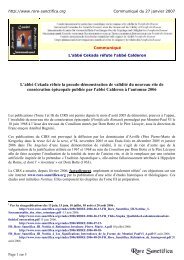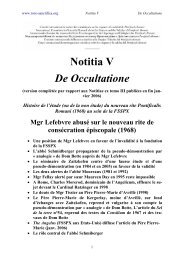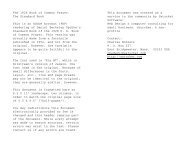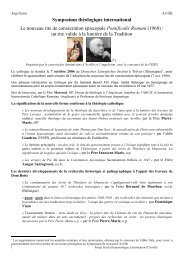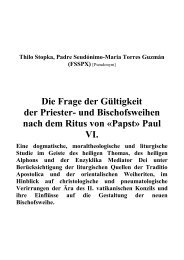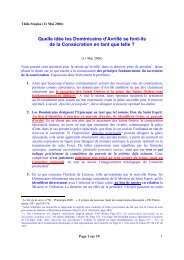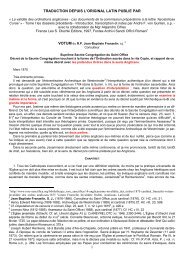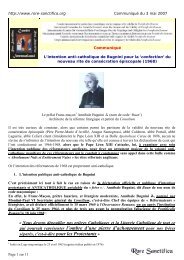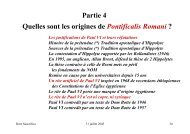THE ORDER OF MELCHISEDECH A Defence of ... - Rore Sanctifica
THE ORDER OF MELCHISEDECH A Defence of ... - Rore Sanctifica
THE ORDER OF MELCHISEDECH A Defence of ... - Rore Sanctifica
You also want an ePaper? Increase the reach of your titles
YUMPU automatically turns print PDFs into web optimized ePapers that Google loves.
Chapter I<br />
The Catholic Priesthood<br />
A characteristic <strong>of</strong> the heresies which have plagued the Church <strong>of</strong> Christ since her foundation is that<br />
they are frequently exaggerations <strong>of</strong> true doctrine. Thus, an exaggerated insistence upon the<br />
Divinity <strong>of</strong> Christ has led to a denial <strong>of</strong> His humanity and vice versa. A danger for those who<br />
uphold truth in the face <strong>of</strong> heresy is to react so strongly against a particular error that they minimize<br />
the valid aspect <strong>of</strong> Catholicism which the heretics had exaggerated, and thus risk falling into error<br />
themselves. Protestants laid such stress upon the universal priesthood <strong>of</strong> the faithful that they ended<br />
up by denying that there is any distinction in essence between a layman and an ordained priest.<br />
Today this error has been widely embraced by Catholic Modernists and it is hardly surprising that<br />
some traditionalists tend to react suspiciously whenever the priesthood <strong>of</strong> the laity is mentioned. As<br />
is almost invariably the case, the Catechism <strong>of</strong> the Council <strong>of</strong> Trent can be referred to for a<br />
balanced exposition <strong>of</strong> the Catholic position. The teaching <strong>of</strong> this Council is explained in its<br />
Catechism as follows:<br />
As Sacred Scripture describes a two-fold priesthood, one internal and the other external, it will be<br />
necessary to have a distinct idea <strong>of</strong> each to enable pastors to explain the nature <strong>of</strong> the priesthood<br />
now under discussion.<br />
Regarding the internal priesthood (interius sacerdotium), all the faithful are said to be priests, once<br />
they have been washed in the saving waters <strong>of</strong> Baptism. Especially is this name given to the just<br />
who have the Spirit <strong>of</strong> God, and who, by the help <strong>of</strong> Divine grace, have been made living members<br />
<strong>of</strong> the great High Priest, Jesus Christ: for, enlightened by faith which is enflamed by charity, they<br />
<strong>of</strong>fer up spiritual sacrifices to God on the altar <strong>of</strong> their hearts. Among such sacrifices must be<br />
reckoned every good and virtuous action done for the glory <strong>of</strong> God. 1<br />
It is also perfectly correct to state that during the Mass the faithful join with the ordained priest at<br />
the altar in <strong>of</strong>fering the Divine Victim. In his sublime encyclical Mediator Dei, Pope Pius XII<br />
wrote:<br />
The fact is clear enough from the statements <strong>of</strong> some <strong>of</strong> our Predecessors and <strong>of</strong> some Doctors <strong>of</strong><br />
the Church . . . The rites and prayers <strong>of</strong> the Mass show no less clearly that the <strong>of</strong>fering <strong>of</strong> the Victim<br />
is made by the priest together with the people . . . Moreover the prayers by which the Divine Victim<br />
is <strong>of</strong>fered to God are said for the most part in the plural, and they more than once indicate that the<br />
people have a part in this sacrifice as being <strong>of</strong>ferers <strong>of</strong> it . . . And there is no wonder that the faithful<br />
are accorded this privilege; by reason <strong>of</strong> their Baptism Christians are in the Mystical Body and<br />
become by a common title members <strong>of</strong> Christ the Priest: by the "character" that is graven upon their<br />
souls they are appointed to the worship <strong>of</strong> God, and therefore, according to their condition, they<br />
share in the priesthood <strong>of</strong> Christ Himself.<br />
But not only do the faithful join with the priest at the altar in <strong>of</strong>fering Christ. Pope Pius XII explains<br />
that:<br />
if the oblation whereby the faithful in this Sacrifice <strong>of</strong>fer the Divine Victim to the heavenly Father<br />
is to produce its full effect, they must do something further: they must also <strong>of</strong>fer themselves as<br />
victim. 2<br />
After explaining the universal priesthood <strong>of</strong> all the faithful, the Catechism <strong>of</strong> the Council <strong>of</strong> Trent<br />
deals with the external priesthood-----sometimes termed the visible or ministerial priesthood.<br />
The external priesthood, on the contrary, does not pertain to the faithful at large, but only to certain<br />
men who have been ordained and consecrated to God by the lawful imposition <strong>of</strong> hands and by the<br />
solemn ceremonies <strong>of</strong> holy Church, and who are thereby devoted to a particular sacred ministry.<br />
This distinction <strong>of</strong> the priesthood can be seen even in the Old Law (the Mosaic priesthood) . . . Now



